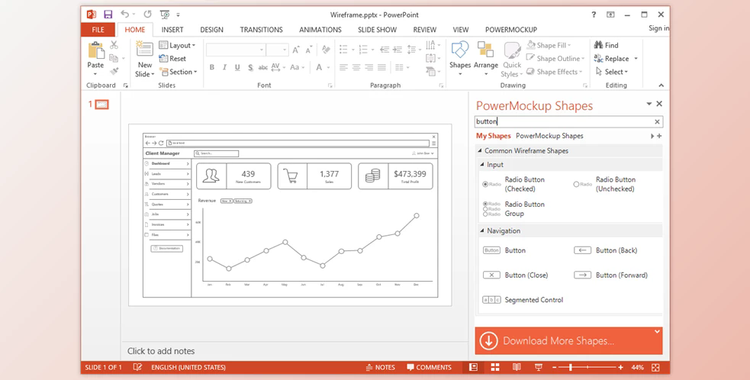
PowerMockup's Stencil Library supplies a broad assortment of templates for all of the normal elements of a site or program: buttons, text boxes, menus, tabs, tables, etc... Using the Stencil Library is as simple as selecting a product and dragging it on a PowerPoint slide. All stencils are based on routine PowerPoint shapes and completely editable.
PowerMockup supplies a massive group of user interface components and icons created entirely from PowerPoint shapes. With these components, you can easily make display prototypes of cellular, internet, and desktop programs --right inside PowerPoint!
The achievement of PowerPoint is linked closely with its simplicity of use and shallow learning curve. Even first-time customers may create demonstrations from scratch in a few minutes. And should you ever get stuck using a PowerPoint issue, you'll discover lots of sites and books offering aid.
Using PowerPoint as a monitoring tool helps ensure that all stakeholders can participate in the development process, even people without design or coding abilities. Nobody gets left out, and all staff members can induce growth.
PowerPoint's demonstration attributes make it a fantastic tool for producing storyboards that show the flow between displays. Slide by slide, it is possible to present a tour of this consumer interface and use cartoons, hyperlinks, and action to incorporate interactivity.
PowerPoint includes cooperation and sharing attributes that ease working in a group. You may share files with others through OneDrive or SharePoint, leave remarks about slides, and merge different versions of a file into one document.
From shared bitmap images (PNG, JPEG, BMP, etc.) over vector images (EMF, WMF, EPS) to movie files (MP4, WMV) and PDF files, PowerPoint supports a vast assortment of export and import formats for slides and shapes.
As part of the Microsoft Office package, PowerPoint performs well with Word and Excel. As an example, you can embed PowerPoint slides into a Word specification document whilst keeping them completely editable.
PowerMockup's instantaneous search feature makes finding the ideal contours a simple endeavor. As you sort, the listing of contours mechanically filters till you get what you're searching for. PowerMockup also recognizes synonyms to ensure an internet search for"Input" yields results such as"Text Box" and"Text Area" items.
As soon as you've located a shape you need to utilize for a wireframe or mockup, drag it in the library to the desired place in your PowerPoint slide. It is fast and simple!
You are also able to add your own items into the contour library. Just pick a contour on a PowerPoint slide, click "Insert Form," and create a customized form. For better company, organize your contours into different categories and subcategories. You can also export and import silhouette categories so that you can share your creations with others.
A number of those PowerMockup shapes deliver added performance that goes beyond what PowerPoint provides. For example, if you resize the"Window" contour, PowerMockup ensures the window title bar retains the appropriate proportions. Some contours also let you make quick adjustments, like adding objects to a tab bar or placing the condition of a test box.
When operating in a group, you might choose to produce a shared repository of commonly used contours. That is exactly what PowerMockup's"Common Ridge Library" attribute is for. It permits you to prepare a form library stored on the internet on the PowerMockup servers, which multiple users may access (based on the rights given ).